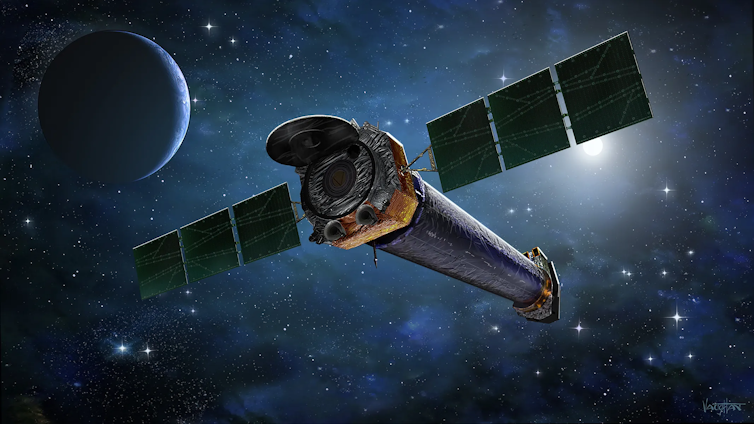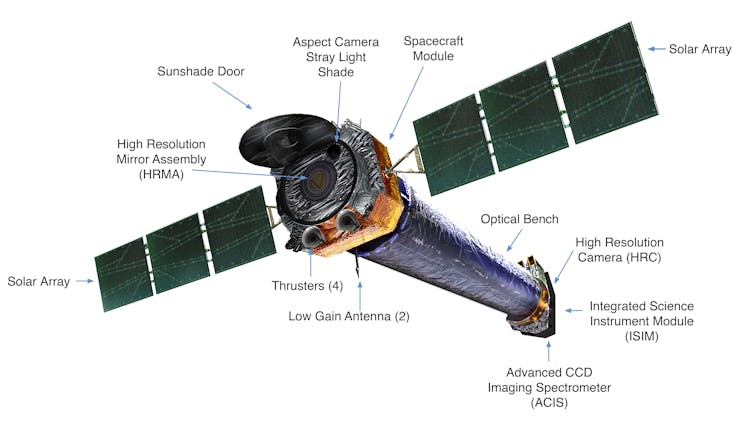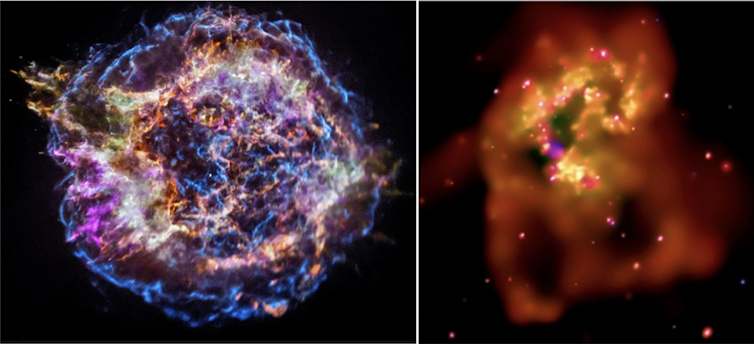
When a star is born or dies, or when any other very energetic phenomenon occurs in the universe, it emits X-rays, which are high-energy light particles that aren’t visible to the naked eye. These X-rays are the same kind that doctors use to take pictures of broken bones inside the body. But instead of looking at the shadows produced by the bones stopping X-rays inside of a person, astronomers detect X-rays flying through space to get images of events such as black holes and supernovae.
Images and spectra – charts showing the distribution of light across different wavelengths from an object – are the two main ways astronomers investigate the universe. Images tell them what things look like and where certain phenomena are happening, while spectra tell them how much energy the photons, or light particles, they are collecting have. Spectra can clue them in to how the event they came from formed. When studying complex objects, they need both imaging and spectra.
Scientists and engineers designed the Chandra X-ray Observatory to detect these X-rays. Since 1999, Chandra’s data has given astronomers incredibly detailed images of some of the universe’s most dramatic events.

Stars forming and dying create supernova explosions that send chemical elements out into space. Chandra watches as gas and stars fall into the deep gravitational pulls of black holes, and it bears witness as gas that’s a thousand times hotter than the Sun escapes galaxies in explosive winds. It can see when the gravity of huge masses of dark matter trap that hot gas in gigantic pockets.

NASA designed Chandra to orbit around the Earth because it would not be able to see any of this activity from Earth’s surface. Earth’s atmosphere absorbs X-rays coming from space, which is great for life on Earth because these X-rays can harm biological organisms. But it also means that even if NASA placed Chandra on the highest mountaintop, it still wouldn’t be able to detect any X-rays. NASA needed to send Chandra into space.
I am an astrophysicist at the Smithsonian Astrophysical Observatory, part of the Center for Astrophysics | Harvard and Smithsonian. I’ve been working on Chandra since before it launched 25 years ago, and it’s been a pleasure to see what the observatory can teach astronomers about the universe.
Supermassive black holes and their host galaxies
Astronomers have found supermassive black holes, which have masses ten to 100 million times that of our Sun, in the centers of all galaxies. These supermassive black holes are mostly sitting there peacefully, and astronomers can detect them by looking at the gravitational pull they exert on nearby stars.
But sometimes, stars or clouds fall into these black holes, which activates them and makes the region close to the black hole emit lots of X-rays. Once activated, they are called active galactic nuclei, AGN, or quasars.
My colleagues and I wanted to better understand what happens to the host galaxy once its black hole turns into an AGN. We picked one galaxy, ESO 428-G014, to look at with Chandra.
An AGN can outshine its host galaxy, which means that more light comes from the AGN than all the stars and other objects in the host galaxy. The AGN also deposits a lot of energy within the confines of its host galaxy. This effect, which astronomers call feedback, is an important ingredient for researchers who are building simulations that model how the universe evolves over time. But we still don’t quite know how much of a role the energy from an AGN plays in the formation of stars in its host galaxy.
Luckily, images from Chandra can provide important insight. I use computational techniques to build and process images from the observatory that can tell me about these AGNs.

The active supermassive black hole in ESO 428-G014 produces X-rays that illuminate a large area, extending as far as 15,000 light years away from the black hole. The basic image that I generated of ESO 428-G014 with Chandra data tells me that the region near the center is the brightest, and that there is a large, elongated region of X-ray emission.
The same data, at a slightly higher resolution, shows two distinct regions with high X-ray emissions. There’s a “head,” which encompasses the center, and a slightly curved “tail,” extending down from this central region.
I can also process the data with an adaptive smoothing algorithm that brings the image into an even higher resolution and creates a clearer picture of what the galaxy looks like. This shows clouds of gas around the bright center.
My team has been able to see some of the ways the AGN interacts with the galaxy. The images show nuclear winds sweeping the galaxy, dense clouds and interstellar gas reflecting X-ray light, and jets shooting out radio waves that heat up clouds in the galaxy.
These images are teaching us how this feedback process operates in detail and how to measure how much energy an AGN deposits. These results will help researchers produce more realistic simulations of how the universe evolves.
The next 25 years of X-ray astronomy
The year 2024 marks the 25th year since Chandra started making observations of the sky. My colleagues and I continue to depend on Chandra to answer questions about the origin of the universe that no other telescope can.
By providing astronomers with X-ray data, Chandra’s data supplements information from the Hubble Space Telescope and the James Webb Space Telescope to give astronomers unique answers to open questions in astrophysics, such as where the supermassive black holes found at the centers of all galaxies came from.
For this particular question, astronomers used Chandra to observe a faraway galaxy first observed by the James Webb Space Telescope. This galaxy emitted the light captured by Webb 13.4 billion years ago, when the universe was young. Chandra’s X-ray data revealed a bright supermassive black hole in this galaxy and suggested that supermassive black holes may form by the collapsing clouds in the early universe.
Sharp imaging has been crucial for these discoveries. But Chandra is expected to last only another 10 years. To keep the search for answers going, astronomers will need to start designing a “super Chandra” X-ray observatory that could succeed Chandra in future decades, though NASA has not yet announced any firm plans to do so.![]()
Giuseppina Fabbiano, Senior Astrophysicist, Smithsonian Institution
This article is republished from The Conversation under a Creative Commons license. Read the original article.